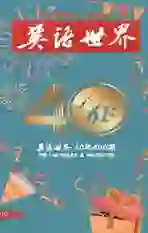Exploring Song Lyrics Translation 聚焦交流方式的变迁
2021-10-22XiaoWeiqing肖维青
Xiao Weiqing 肖维青
Translators are often regarded as unsung heroes. But translators are not unsung heroes—not if you consider how often their translated texts are literally sung.
Almost everyone hears songs every day. All cultures have songs, with words in their own languages: they sing old songs and they make new ones. Clearly, the verbal elements of vocal music cannot cross linguistic borders as readily as the music elements. This is regrettable but it is not irremediable, since the skill of translators can come into play. Indeed, translation has long played an important role in the field of music, though an often underrated one.
Translating songs has at least two purposes: one for reading on paper or on screens and the other is for translating singable or performable songs. If you assume that there exists one all-purpose translation, your assumption is false. Whether the translation will be printed, screened or sung will influence the translators strategies.
While translating songs for reading, the translator needs to bear in mind that song lyrics are characteristic of literary texts, especially of poems, and as such they differ greatly from plain daily conversation or rigid written prose. Song lyrics and poems are twin sisters. From The Book of Songs to The Songs of the South, Collection of Yuefu Lyric Poems, from Tang Poetry to Poetry of the Song Dynasty, even to Yuan Dynasty Drama, some song-texts began life as printed poems, or the other way around. We can find abundant examples of such in modern and contemporary Chinese literature. “Macao”, for example, the first of the series of poems entitled Songs of the Seven Sons composed by Wen Yiduo, was adapted into a song for the ceremony of Macaos return to China in 1999. Not only in China, but also in the English world, poems and song lyrics are closely related. For instance, “Auld Lang Syne” is so popular a song that half the world even forgot the origin of the song was a poem written by Robert Burns, an 18th century Scottish poet.
All the examples above show that many song texts contain some of the features typical of poetry; to put it another way, song-texts or song lyrics, resemble poems. Therefore, when we translate song lyrics, we need to make our translation read like poems, more or less.
“Scarborough Fair”, a century-old English ballad, can be translated literally, but most readers would favor the more poetic version on the right.
Are you going to Scarborough Fair
Parsely, sage, rosemary and thyme.
Remember me to one who lives there.
She once was a true love of mine.
你这是去思卡堡集市吗?
芫荽,鼠尾草,迷迭香和百里香。
代我问候那里的一位朋友,
她曾经是我的挚爱。
Translating for reading is not the only purpose of translating songs. Sometimes the end product needs to be performable. Translating singable songs is subject to multiple constraints—the translator needs to know about music and singing besides the source language and the target language. On top of the normal consideration of meaning, singable translations require careful attention to ease of articulation, rhythm and often rhyme. Here are three tips:
Start with the key phrase/sentence.
Follow Syllable-Character Rule.
Rhyme as much as possible.
There are other tips, like: try to have open-ended syllables, avoid consonant clusters, or be sparing with plosive consonants. For a green hand of song translation, however, these tips are a bit too highbrow. So let us focus on the first three rules of thumb.
1. Start with the key phrase/sentence. Dont automatically start at the beginning. Try to identify the crucial part of the text, usually the line most often repeated.
2. Follow Syllable-Character Rule. As to English-Chinese translation, one English syllable matches one Chinese character. If there are eight English syllables in a line, the translator is supposed to come up with a Chinese sentence containing eight Chinese characters.
3. Rhyme as much as possible. We need to know that the rhyme scheme is not necessarily the same as in the source text, but the translator should try to rhyme as much as possible to fit pre-existing music.
Consider a few lines from 我和我的祖国. This following translated version can be set to the music of the Chinese song, and is (relatively) singable, though not totally faithful to the original. In parentheses are numbers of Chinese characters or numbers of English syllables for each line. Obviously, the translation has observed the Syllable-Character Rule quite well. And the rhyming is neat too.
我和我的祖國(6)
一刻也不能分割(7)
无论我走到哪里(7)
都流出一首赞歌(7)
我歌唱每一座高山(8)
我歌唱每一条河(7)
袅袅炊烟小小村落(8)
路上一道辙(5)
Song-lyrics are not typical texts in any language: they are creative and often playful. Investigating their quirks may provide a fun alternative to the generally informative texts that you may be working on and may well help to enlarge your “tool kit” for solving translating problems.
My motherland and I, (6)
Shall naught be separated by. (8)
No matter where I have gone, (7)
I sing Her praises in song. (7)
I sing of Her mountains so true, (8)
I sing of Her rivers, too. (7)
Sing of villages, big or small, (7)
Sing of them once more. (5)
